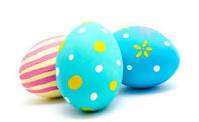Traditions are fun and I would like to share one with you. When my kids were small we would go out on Saturday before Easter and plant jelly beans and then the next day Easter morning they would run outside to find lollipops. Special decorated ones. It has been a favorite tradition till they grew out of it now I have the pleasure to watch them, even virtually, plant their jelly beans so carefully and then hear their squeals the next day when they find their special lollipops.
If you have small ones, I will share my tradition with you, its alot of fun.
Now for the rest of the fun facts…of April
The term “April Fools” was probably meant as a deliberate stab at All Saints (November 1) and All Souls (November 2) Day. Although the origin of playing practical jokes and pranks on this day is hazy, many folklorists believe it may go back to 16th century France. At that time, New Year’s Day was March 25, with a full week of partying and exchanging gifts until April 1. In 1582, the Gregorian calendar moved New Year’s Day to January 1. Those who forgot or refused to honor the new calendar were teasingly called, “April Fools” Weather folklore states, “If it thunders on All Fools’ Day, it brings good crops of corn and hay.

According to THE EASTER BOOK by Francis . Weiser, The origin of the Easter egg is based on the fertility lore of the Indo-European races. To our pre-Christian ancestors, it was a most startling event to see a new and live creature emerge from a seemingly dead object. The egg to them became a symbol of spring. Long ago in Persia, people used to present each other with eggs at the spring equinox, which for them also marked the beginning of a new year.
In Judiasm, eggs are an important part of the Passover seder plate. For some Christians, the egg symbolizes the rock tomb out of which Christ emerged to the new life of his Resurrection. Also, there was a practical reason why eggs became popular on Easter: They were forbidden during the 40 days of Lent. However, chickens still laid eggs, so they were often collected and decorated.
In most countries, the eggs are stained in plain vegetable dye colors. Among Orthodox Christians, the faithful present each other with crimson eggs in honor of the blood of Christ. In parts of Eastern Europe, it’s tradition to create intricate designs on the egg with was or twine before coloring. Called pysanki, these special eggs are saved from year to year like symbolic heirlooms and can be seen seasonally in Ukrainian shops. In Germany and other countries, the eggs are pierced and made hollow so that they can be suspended from shrubs and trees during the Easter Week, muck like on a Christmas tree.
Of course, many countries have egg hunts and games, too. Plastic eggs are often filled with candy treats since it’s the end of Lent. Every year in Washingon, DC there is an egg rolling party on the lawn of the White Huse. This custom is traced back to Sunday School picnics and parades at Easter in the years before the Civil War. At these picnics, the children amused themselves with various games, and egg rolling was one of them.
